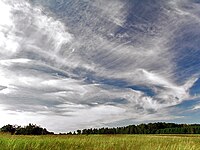
Photo from wikipedia
Cirrus cloud contributes significantly to earth's radiation budget and the greenhouse effect. The Advanced Himawari Imager (AHI) onboard the Himawari-8 satellite lacks a 1.37 μm band, sensitive to monitoring cirrus… Click to show full abstract
Cirrus cloud contributes significantly to earth's radiation budget and the greenhouse effect. The Advanced Himawari Imager (AHI) onboard the Himawari-8 satellite lacks a 1.37 μm band, sensitive to monitoring cirrus clouds. This article proposed a conditional generative adversarial network-based data-to-data translation (D2D) model to generate a hypothetical AHI 1.37 μm band. For training and testing the D2D model, the Geo-Kompsat-2A Advanced Meteorological Imager (AMI) 1.37 μm bands and other highly correlated bands to cirrus from July 24, 2019 to July 31, 2020, were used. The D2D model exhibited a high level of agreement (mean of statistics: correlation coefficient (CC) = 0.9827, bias = 0.0004, and root-mean-square error (RMSE) = 0.0086 in albedo units) between the observed and D2D-generated AMI 1.37 μm bands from validation datasets. The application of the D2D model to the AHI sensor showed that the D2D-generated AHI 1.37 μm band was qualitatively analogous to the observed AMI 1.37 μm band (average of statistics: bias = 0.0026, RMSE = 0.0191 in albedo units, and CC = 0.9158) on the 1st, 15th, and 28th of each month of 2020 in the common observing regions between Korea and Japan. The validation results with the CALIPSO data also showed that the D2D-generated AHI 1.37 μm band performed similarly to the observed AMI 1.37 µm band. Consequently, this article can significantly contribute to cirrus detection and its application to climatology.
Journal Title: IEEE Journal of Selected Topics in Applied Earth Observations and Remote Sensing
Year Published: 2023
Link to full text (if available)
Share on Social Media: Sign Up to like & get
recommendations!